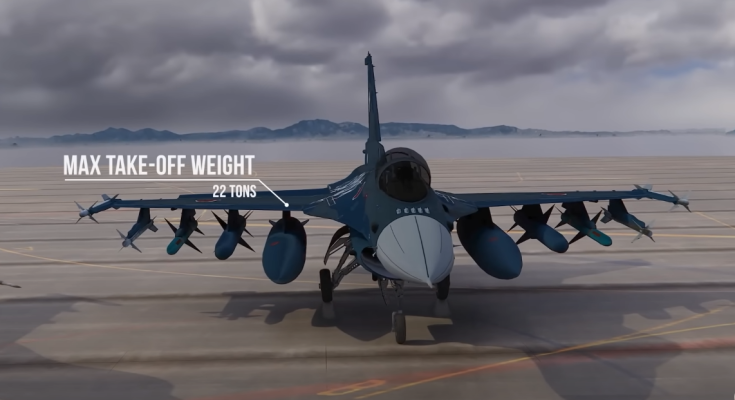The Japanese F-2, often referred to as the “reinvented F-16,” is a fascinating example of how a country took a proven airframe and tailored it to meet its own specific needs, effectively improving on the original design. The F-2 is a result of a collaboration between the United States and Japan, and it represents how Japan managed to enhance and adapt the F-16 Fighting Falcon platform to suit its own operational requirements. The story behind the F-2 reveals how Japan took an already successful fighter jet and, through innovation and engineering, turned it into a more capable, versatile, and regionally specialized aircraft.
The Genesis of the F-2
In the 1980s, Japan sought a replacement for its aging fleet of F-4 Phantom II fighters. The Japanese Ministry of Defense (MOD) wanted an aircraft that could provide superior capabilities in air defense, ground attack, and maritime strike operations. After evaluating various options, Japan decided to base its next-generation fighter on the American F-16 Fighting Falcon, a fighter known for its agility, versatility, and relatively low operating costs.
However, rather than simply adopting the F-16 as it was, Japan worked closely with the United States to develop an upgraded version. This resulted in the Japanese F-2, which first entered service in 2000 with the Japan Air Self-Defense Force (JASDF).
Key Enhancements to the F-2
- Larger Airframe: One of the most obvious differences between the F-2 and the original F-16 is the size of the airframe. The F-2 is notably larger, with a wingspan that is 25% greater than that of the F-16. This increased wingspan improves the aircraft’s maneuverability and range, allowing it to carry more fuel and munitions. The larger airframe also provides greater stability and better lift, which enhances its performance in both air-to-air and air-to-ground missions.
- Advanced Composite Materials: Japan’s use of advanced composite materials in the F-2’s construction significantly reduces the aircraft’s weight while improving its strength and durability. The aircraft’s fuselage and wings are constructed using lightweight materials such as carbon fiber-reinforced plastic, which increases fuel efficiency, reduces the aircraft’s radar signature, and allows it to maintain better performance over longer missions. This use of composites was a major leap forward for Japanese aerospace engineering, allowing them to create an aircraft that is both strong and light.
- Improved Avionics and Radar: The F-2’s avionics and radar systems were upgraded with more advanced technology compared to the original F-16. The Japanese-designed radar system, the J/APG-2, is an enhanced version of the radar in the F-16, offering improved air-to-ground and air-to-air capabilities. The radar’s ability to detect and track targets at longer ranges, as well as operate in more cluttered environments, made the F-2 more effective in modern combat scenarios. Additionally, the avionics suite includes Japanese-made systems for navigation, targeting, and communication, improving the aircraft’s effectiveness in joint operations.
- Enhanced Weaponry and Maritime Strike Capability: Japan’s specific defense needs shaped the F-2’s weaponry, especially its maritime strike capabilities. While the F-16 is already capable of carrying a wide variety of air-to-air and air-to-ground weapons, the F-2 was designed to specialize in anti-ship and anti-surface operations. It is equipped to carry Japan’s indigenous ASM-1 and ASM-2 anti-ship missiles, which are crucial for Japan’s defense against potential maritime threats in the Pacific. The aircraft’s design also includes provisions for improved targeting pods and precision-guided munitions.
- Upgraded Cockpit: The F-2 also boasts an improved cockpit design tailored to the needs of Japanese pilots. The cockpit features a larger, more advanced multifunctional display, which provides pilots with a better overview of the battlefield. The heads-up display (HUD) is also enhanced for easier target acquisition, and the seat is designed for greater comfort during long-duration flights, which is particularly important for Japan’s extended patrols and surveillance missions in the Pacific.
The Impact of the F-2
The F-2’s reinvention of the F-16 represents a strategic shift for Japan’s defense forces. The modifications not only enhanced the aircraft’s performance but also reflected Japan’s focus on self-reliance in military technology. The F-2 was able to fill a unique role within Japan’s defense structure, particularly in countering maritime threats and conducting air defense missions.
Despite the F-2 being more advanced than the original F-16, it also came with a high cost. The aircraft’s development and production were expensive, which limited the number of F-2s Japan could procure. The final tally was 50 units, far fewer than the hundreds of F-16s flown by the U.S. and other nations. This made the F-2 a relatively rare asset, but one that is highly specialized and uniquely suited to Japan’s needs.
Conclusion
The Japanese F-2 represents a remarkable example of how an existing airframe, in this case, the F-16, can be significantly improved through thoughtful design, innovation, and adaptation to specific national defense needs. By enhancing the airframe, avionics, and weaponry, Japan has created a fighter that is better suited for its regional defense priorities, particularly in the maritime environment of the Pacific. While the F-2 is no longer in production, its legacy continues to influence the design of Japan’s next-generation fighters and remains a testament to the nation’s capabilities in aerospace engineering and defense technology.



